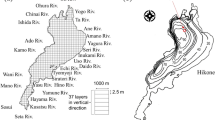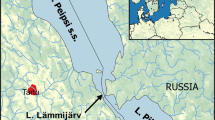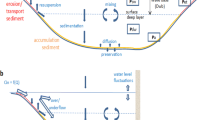Abstract
The effects of a single lake on downstream water chemistry may be compounded by the presence of additional lakes within the watershed, augmenting or negating the effects of the first lake. Multiple, linked lakes are a common feature of many watersheds and these resemble reactors in series often studied in engineering. The effects of multiple lakes in series on nutrient transport are largely unexplored. We populated and calibrated a simple lake model to investigate the role of a sub-alpine lake (Bull Trout Lake (BTL), Rocky Mountains, USA) on the transport of the macronutrients during the summer of 2008. Further, we developed a sequential model in which four identical lakes (copies of the BTL model) were connected in series. All lakes in the sequence retarded the flux of nutrients, thus slowing their transport downstream. The first lake in the sequence dramatically altered stream water chemistry and served as a sink for C and P and a source of N, while additional lakes downstream became sources of C, N and P. Although additional downstream lakes resulted in important changes to water chemistry and nutrient transport, the nature of the changes were similar from Lakes 2 to 4 and the magnitude of the changes diminished with distance downstream. Our lake model served as an effective tool for assessing the nutrient budget of the lake and the hypothetical effect of multiple lakes in sequence in a landscape limnology framework.










Similar content being viewed by others
References
Epstein DE (2011) 15 N tracer and modeling analyses of nutrient transport through lakes in a subalpine watershed. Master’s Thesis, 107 pp, Utah State University, Logan, UT
Alexander RB, Elliott AH, Shankar U, McBride GB (2002) Estimating the sources and transport of nutrients in the Waikato River Basin, New Zealand. Water Resour Res 38:1268
Arp CD, Gooseff MN, Baker MA, Wurtsbaugh W (2006) Surface-water hydrodynamics and regimes of a small mountain stream-lake ecosystem. J Hydrol 329:500–513
Arp CD, Schmidt JC, Baker MA, Myers AD (2007) Stream geomorphology in a mountain lake district: hydraulic geometry, sediment sources and sinks, and downstream lake effects. Earth Surf Proc Land 32:525–543
Barko JW, Gunnison D, Carpenter SR (1991) Sediment Interactions with submersed macrophyte growth and community dynamics. Aquat Bot 41:41–65
Baron JS, Campbell DH (1997) Nitrogen fluxes in a high elevation Colorado Rocky Mountain basin. Hydro Process 11:783–799
Brown PD, Wutsbaugh WA, Nydick KR (2008) Lakes and forests as determinants of downstream nutrient concentrations in small mountain watersheds. Arct Antarct Alp Res 40:462–469
Carpenter SR (1980) Enrichment of Lake Windgra, Wisconsin, by submersed macrophyte decay. Ecology 61:1145–1155
Chapra SC, Martin JL (2004) LAKE2K, a modeling framework for simulating lake water quality (Version 1.2): documentation and users manual. Civil and Environmental Engineering Dept., Tufts University, Medford, MA
Craft CB, Seneca ED, Broome SW (1991) Loss on ignition and kjeldahl digestion for estimating organic-carbon and total nitrogen in estuarine marsh soils—calibration with dry combustion. Estuaries 14:175–179
Duarte CM, Kalff J (1989) The influence of catchment geology and lake depth on phytoplankton biomass. Arch Hydrobiol 115:27–40
Dugdale VA, Dugdale RC (1965) Nitrogen metabolism in Lakes III. Tracer studies of the assimilation of inorganic nitrogen sources. Limn Oceanogr 10:53–57
Effler SW, O’Donnell SM, Prestigiacomo AR, O’Donnel DM, Matthews DA, Owens EM, Effler AJP (2009) Tributary plunging in an urban lake (Onondaga Lake): drivers, signatures, and implications. J Am Water Resour Assoc 45:1127–1141
Fleenor WE, Schladow SG (2000) Mixing in the plunge zone of lake inflows. In: Proceedings of the Fifth International Symposium on Stratified Flows. Vancouver, BC, pp 307–312
Garret J (2010) Pervasive thermal consequences of stream–lake interactions in small Rocky Mountain watersheds, USA. Master’s Thesis, Utah State University, Logan, UT
Goodman KJ (2010) The effect of in-line lakes on dissolved organic matter dynamics in mountain streams. Utah State University, Logan
Goodman KJ, Baker MA, Wurtsbaugh WA (2011) Lakes as buffers of stream dissolved organic matter (DOM) variability: Temporal patterns of DOM characteristics in mountain stream-lake systems. J Geophys Res 116:15. doi:10.1029/2011JG001709
Hall RO, Baker MA, Arp CD, Koch BJ (2009) Hydrologic control of nitrogen removal, storage, and export in a mountain stream. Limnol Oceanogr 54:2128–2142
Harrison JA, Maranger RJ, Alexander RB, Giblin AE, Jacinthe P, Mayorga E, Seitzinger SP, Sobota DJ, Wollheim WM (2008) The regional and global significance of nitrogen removal in lakes and reservoirs. Biogeocehmistry 93:143–157
Hessen DO, Anderson T, Brettum P, Faafeng BA (2003) Phytoplankton contribution to sestonic mass and elemental ratios in lakes: implications for zooplankton nutrition. Limn Oceanogr 48:1289–1296
Hillbricht-Ilkowska A (1999) Shallow lakes in lowland river systems: role in transport and transformation of nutrients and in biological diversity. Hydrobiologia 408(409):349–358
Hood E, McKnight DM, Williams MW (2003) Sources and chemical character of dissolved organic carbon across an alpine/subalpine ecotone, Green Lakes Valley, Colorado Front Range, United States. Water Resour Res 39:G01007
Horne AJ, Goldman CR (1994) Limnology. McGraw-Hill, New York
Janse JH, Van Donk E, Aldenberg T (1998) A model study on the stability of the macrophyte-dominated state as affected by biological factors. Water Res 32:2696–2706
Jansson M (1979) Nutrient budgets and the regulation of nutrient concentrations in a small sub-arctic lake in northern Sweden. Freshwat Biol 9:213–231
Johnson LB, Richards C, Host GE, Arthur JW (1997) Landscape influences on water chemistry in Midwestern stream ecosystems. Freshwat Biol 37:193–208
Jones NE (2010) Incorporating lakes within the river discontinuum: longitudinal changes in ecological characteristics in stream-lake networks. Can J Fish Aquat Sci 67:1350
Kaste O, Dillon PJ (2003) Inorganic nitrogen retention in acid-sensitive lakes in southern Norway and southern Ontario, Canada—a comparison of mass balance data with an empirical N retention model. Hydrol Process 17:2393–2407
Kling GW, Kipphut GW, Miller MM, O’Brien JO (2000) Integration of lakes and streams in a landscape perspective: the importance of material processing on spatial patterns and temporal coherence. Freshw Biol 43:477–497
Koch BJ (2005) Invertebrate-mediated nitrogen cycling in three connected aquatic ecosystems. Master’s Thesis, University of Wyoming, Laramie, WY, 54 pp
Kratz TK, Webster KE, Bowser CJ, Magnuson JJ, Benson BJ (1997) The influence of landscape position on lakes in northern Wiscosin. Freshw Biol 37:209–217
Larson JH, Frost PC, Zheng Z, Johnston CA, Bridgham SD, Lodge DM, Lamberti GA (2007) Effects of upstream lakes on dissolved organic matter in streams. Limnol Oceanogr 52:60–69
Maciolek JA, Tunzi MG (1968) Microseston dynamics in a simple Sierra Nevada lake-stream system. Ecology 49:60–75
Marcarelli AM, Wurtsbaugh WA (2007) Effects of upstream lakes and nutrient limitation on periphytic biomass and nitrogen fixation in oligotrophic, subalpine streams. Freshw Biol 52:2211–2225
Marcarelli AM, Wurtsbaugh WA (2009) Nitrogen fixation varies spatially and seasonally in linked stream–lake ecosystems. Biogeochemistry 94:95–110
Menzel DW, Vacarro RF (1964) The measurement of dissolved and particulate organic carbon in seawater. Limnol Oceanogr 9:138–142
Meyer JL, Likens GE (1979) Transport and transformation of phosphorus in a forest stream ecosystem. Ecology 60:1255–1269
Mulholland PJ, Valett HM, Webster JR, Thomas SA, Cooper LW, Hamilton SK, Peterson BJ (2004) Stream denitrification and total nitrate uptake rates measured using a field 15 N tracer. Limnol Oceanogr 49:809–820
Murphy J, Riley JP (1962) A modified single solution method for the determination of phosphate in natural waters. Anal Chim Acta 27:31–36
NADP (2001) Annual Summary National Atmospheric Deposition Program Data Report 2000–2001, Illinois State Water Survey, Champaign, IL
NRCS (2008) Idaho Snow Survey, United Stated Department of Agriculture. Boise, Idaho
Otsuki A, Hanya T (1972) Production of dissolved organic matter from dead green algal cells I. Aerobic microbial decomposition. Limnol Oceanogr 17:248–257
Persson G, Broberg O (1985) Nutrient concentrations in the acidified Lake Gardsjon: the role of transport and retention of phosphorus, Nitrogen and DOC in watershed and lake. Ecol Bull 37:158–175
Redfield AC (1934) On the proportions of organic derivatives in sea water and their relation to the composition of plankton. In: James Johnstone Memorial Volume Liverpool, pp 176–192
Reuter JE, Axler RP (1992) Physiological characteristics of inorganic nitrogen uptake by spatially separate algal communities in a nitrogen deficient lake. Freshw Bio 27:227–236
Rich PH, Wetzel RG (1978) Detritus in a lake ecosystem. Am Nat 112:57–71
Riera JL, Magnuson JJ, Kratz TK, Webster KE (2000) A geomorphic template for the analysis of lake districts applied to the Northern Highland Lake District, Wisconsin, USA. Freshw Biol 43:301–318
Sawatzky CL, Wurtsbaugh WA, Luecke C (2006) The spatial and temporal dynamics of deep chlorophyll layers in high-mountain lakes: effects of nutrients, grazing and herbivore nutrient recycling as growth determinants. J Plankt Res 28:65–86
Sferratore A, Billen G, Garnier J, Smedberg E, Humborg C, Rahm L (2008) Modelling nutrient fluxes from sub-arctic basins: comparison of pristine vs. dammed rivers. J Marine Syst 73:236–249
Sickman JO, Melack JM, Clow DW (2003) Evidence for nutrient enrichment of high-elevation lakes in the Sierra Nevada, California. Limnol Oceanogr 48:1885–1892
Solorazo L (1969) Determination of ammonia in natural water by the phenolhypochlorite method. Limnol Oceanogr 14:799–801
Soranno PA, Cheruvelil KS, Webster KE, Bremigan MT, Wagner T, Stow CA (2010) Using landscape limnology to classify freshwater ecosystems for multi-ecosystem management and conservation. Bioscience 60:440–454
Stanford JA, Ward JV (2001) Revisiting the serial discontinuity concept. Regul Rivers 17:303–310
Swanson FJ, Johnson SL, Gregory SV, Acker SA (1998) Flood disturbance in a forested mountain landscape. Conserv Biol 14:76–85
Vadeboncoeur Y (1994) Longitudinal dynamics of seston concentration and composition in a lake outlet stream. J N Am Benthol Soc 132:181–189
Vadeboncoeur Y, Lodge DM, Carpenter SR (2001) Whole-lake fertilization effects on distribution of primary production between benthic and pelagic habitats. Ecology 82:1065–1077
Vadeboncoeur Y, Vander Zanden MJ, Lodge DM (2002) Putting the lake back together: reintegrating benthic pathways into lake food web models. Biosci 52:44–54
Valderrama JC (1981) The simultaneous analysis of total nitrogen and total phosphorus in natural waters. Mar Chem 10:109–122
Vander Zanden MJ, Rasmussen JB (1996) A trophic position model of pelagic food webs: impact on contaminant bioaccumulation in lake trout. Ecol Monogr 66:451–477
Welschmeyer NA (1994) Fluorometric analysis of chlorophyll a in the presence of chlorophyll b and pheopigments. Limnol Oceanogr 39:1985–1992
Wurtsbaugh W, Gross H, Luecke C, Budy P (1997) Nutrient limitation of oligotrophic sockeye salmon lakes of Idaho (USA). Verh Internat Verein Limnol 26:413–419
Wurtsbaugh W, Baker MA, Gross H, Brown P (2005) Lakes as nutrient “sources” for watersheds: a landscape analysis of the temporal flux of nitrogen through sub-alpine lakes and streams. Verh Internat Verein Limnol 29:645–649
Acknowledgments
We would like to thank Brian McGlynn, Michelle Baker, Michelle Kang, Caleb Izdepski, Ian Washbourne, Tim Covino, Malcolm Herstad, Alexi Kalanin, Cyri Dixon, Natalie Day, Rene Henery and Heloisa Rutigliano for assistance in data collection. Susan Durham assisted in statistical analysis of data. The U.S. Forest Service provided access to the study site. We would like to thank four anonymous reviewers whose comments greatly improved this manuscript. This research was funded by a Grant from the National Science Foundation (DEB 05-19327) awarded to Wayne A Wurtsbaugh and Michelle A Baker.
Author information
Authors and Affiliations
Corresponding author
Rights and permissions
About this article
Cite this article
Epstein, D.M., Neilson, B.T., Goodman, K.J. et al. A modeling approach for assessing the effect of multiple alpine lakes in sequence on nutrient transport. Aquat Sci 75, 199–212 (2013). https://doi.org/10.1007/s00027-012-0267-2
Received:
Accepted:
Published:
Issue Date:
DOI: https://doi.org/10.1007/s00027-012-0267-2




